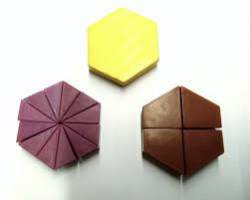Summary
This lesson continues to develop an understanding of fractions and builds a foundation for understanding the addition of fractions. Students engage in thoughtful mathematical conversations and use manipulatives to prove their thinking.
Essential Question(s)
What are fractions composed of?
Snapshot
Engage
Students use a Fold The Line strategy to discuss whether an equation is true or false.
Explore
Using manipulatives, students prove or disprove decomposed fraction problems.
Explain
Students discuss their observations from the Explore section.
Extend
Students explore a fraction addition problem with like denominators.
Evaluate
Using a Window Notes strategy, students summarize their understanding of decomposing fractions.
Materials
Decomposing Fractions handout
Small whiteboards or similar alternative
Fraction bars
Fraction strips
Number lines
Pattern blocks
Engage
Ask students to think about the following equation: ¼ + ¼ + ¼ = ¾
Introduce the Fold the Line strategy. Assign one side of the room to be “True” and one side of the room to be “False." Have students decide if the equation is true or false and report to the side of the room represents their belief.
Within their true and false groups, have students partner and discuss why they think the equation is true or why it is false.
Next, have the students pair with someone on the other side of the room that thinks the opposite of them. Again, have students discuss why they think the equation is true or why it is false. Listen to student conversations and make sure students discuss their reasoning.
Explore
Give students fraction manipulatives (1/4ths, 1/12ths), number lines (divided into 1/4ths, 1/12ths), and fraction bars (1/4ths, 1/12ths).
Working in small groups or pairs, have students use the manipulatives to prove or disprove the equation, ¼ + ¼ + ¼ = ¾
Ask students to prove or disprove the following equations: (a handout is attached if you wish to provide one to the students):
? + ? = ?
¼ + ¼ = 2/8
1/10 + 1/10 + 1/10 + 1/10 + 1/10 = 5/10 (Extra challenge: What else could this answer be equal to?)
? + ? + ? = ?
¼ + ¼ + ¼ = ¾
¼ + ¼ + ¼ + ¼ = 4/4 (Extra challenge: What else could this answer be equal to?)
Explain
In a guided discussion, ask students to share some of the things they discovered in the Explore activity.
Ask students, "What are some rules you have come up with to prove or disprove fraction equations?"
Address the vocabulary students that will be used in composing and decomposing of fractions. Ask students, "Are there other places we hear these words, compose and decompose?" Examples include: In music, we talk about composing songs and in science, we refer to things decomposing in the environment.
Allow students to use a small whiteboard or pattern blocks to think about and draw answers to the following question: “How would we decompose 5/6?“
Ask the students to create the fraction using the pattern blocks.
For example, students may use triangles as the manipulative unit. Students make another shape, such as a hexagon, to compose the "whole" (6/6).
Next, ask them to decompose the fraction and explain their reasoning. In the triangle example, they would remove one of the triangles to decompose the whole (6/6) and create the fraction, 5/6. They might want to draw pictures and/or write a sentence to explain their answers. Students should be encouraged to use mathematical vocabulary.
Extend
Use a Think Pair Share strategy and ask students, “What would happen if we had ? + ??” Give students a moment to write down their ideas, then have them pair and share their thoughts. Pick a few students to share their ideas with the class.
Ask students, “Are there other ways to write the equation?” and “Can you think of other problems that would be similar?”
Revisit the original problem from the Engage section of the lesson: ¼ + ¼ + ¼ = ¾
Ask students to think about this equation again. Is it true or false? Reveal that the answer is true, and ask students to show how they know it based on the knowledge they have gained in the lesson.
Evaluate
Using the Window Notes strategy, have students summarize their thoughts and understandings about decomposing fractions.
Fold the paper into four sections.
Label the sections: 1) The Facts: fill with the facts about what they know, 2) My Process: fill with the process they use to solve problems, 3) My Questions: fill with questions they still have, and 4) The Model: make a visual picture of their understanding.
Give students 5-10 minutes to complete their “windows."
Collect the students' Window Notes and use their questions and responses to inform your next learning opportunity.
Resources
K20 Center. (n.d.). Fold the line. Strategies. Retrieved from https://learn.k20center.ou.edu/strategy/d9908066f654727934df7bf4f5079658
K20 Center. (n.d.). Think-pair-share. Strategies. Retrieved from https://learn.k20center.ou.edu/strategy/d9908066f654727934df7bf4f5064b49
K20 Center. (n.d.). Window notes. Strategies. Retrieved from https://learn.k20center.ou.edu/strategy/fc74060730ea745c8c4f356aa2015ac0


